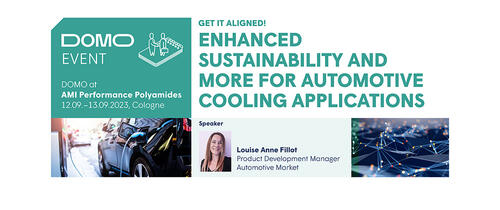- PA6, PA66, PA6.10 or PA66/6.10-based solutions for automotive cooling systems (IC Engines-Hybrids & Fully electric)
- A new recycled based formulation with improved coolant resistance
- PA6, PA6.10/PA66 and PA6.10-based solutions, for extruded electric vehicle (EVs/HEVs) cooling circuit lines with high barrier properties to refrigerants.
PRESENTATION ABSTRACT
The switch toward a more electrified mobility has changes the need for performance solutions also in cooling automotive applications.
The latest development in this respect is the new version of our popular TECHNYL® A 218 V30 BK 34NG, based on recycled feedstock. This unique, coolant resistant solution for cooling applications provides similar performance to the virgin-based alternative, can be molded under similar molding conditions and is also laser markable.
This is yet another addition to our complete toolbox of DOMO solutions for cooling applications to meet our customers’ most demanding requirements.
The well-established virgin polyamide 66-based and 30% GF TECHNYL® A 218 V30 BK 34NG are proven solutions designed to improve resistance to automotive cooling liquids, increasing the lifetime of parts in constant contact with such liquids.
For extremely high coolant resistance, there are also alternative engineered materials based on PA6.10 or PA66/6.10, offering dimensional stability and cooling performance close to PPA compounds. While, for moderate coolant ageing temperatures, like those encountered in electric vehicles, DOMO has developed a specific PA6-based compound with coolant ageing that has been successfully tested for 12 000h at 80°C.
The cooling range at DOMO is also including grades specifically designed for extrusion electric vehicle (EVs/HEVs) cooling circuit lines. During the presentation Louise Anne Fillot will guide you through the best solution based on the level of pressure within the cooling circuit.

